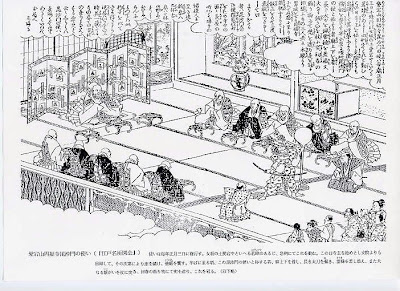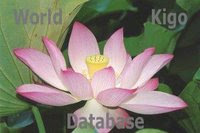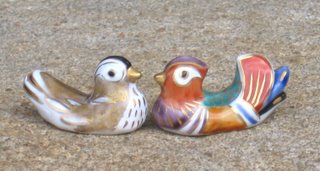. hashiri Daikoku 走り大黒 / 波之利大黒天 .
:::::::::::::::::::::::::::::::::::::::::::::::::::::::::::::::::::::::::::::::::::::::::::::::::::::
Daikoku Ten 大黒天
The Shinto version is written with a different character
大国 Okuninushi
DAIKOKU, DAIKOKU-TEN (Sanskrit = Mahakala)
MAKAKARA, MAKIAKARA-TEN
Name literally means "Great Black Deva"
One of the Seven Gods of Good Luck.
Details are here
Mark Schumacher
。。。。。

sanmen Daikoku 三面大黒 Daikoku with three faces and six arms
The left face is of Bishamonten 毘沙門天 (Vaisravana),
the right face is of Benzaiten 弁才天 (Sarasvati).
。Japanese Reference .

source : www.sendai-shichifukujin.com
秀林寺 Shurin-Ji - Sendai
.......................................................................
He is often seen in combination with Ebisu, Deity of the Fishermen
. Ebisu えびす 恵比寿 .

:::::::::::::::::::::::::::::::::::::::::::::::::::::::::::::::::::::::::::::::::::::::::::::::::::::
kigo for the New Year
hatsu Daikoku 初大黒(はつだいこく)
first Daikoku ceremony
hatsu ki no e ne, hatsu kinoene 初甲子 (はつきのえね)
first day of the rat and the element water
..... hatsu kasshi 初甲子(はつかっし)
The rat (mouse) is closely related to Daikoku.
She is the zodiac sign of midnight and the north, and on the day of the rat a ritual offering of 100 black beans is given to Daikoku.
. Rat and Water day ...
Rituals for Sun Waiting
. WKD : New Year Ceremonies
.................................................................................
observance kigo for mid-winter
Daikoku matsuri 大黒祭(だいこくまつり)
Daikoku festival
nematsuri, ne matsuri 子祭 (ねまつり) Rat/Mouse festival

futamata daikon 二股大根(ふたまただいこん)
bifurcated radish
yome daikon 嫁大根(よめだいこん)"radish like a bride"
tooshin uri 燈心売(とうしんうり)vendors of wicks
netooshin 子燈心(ねとうしん) wick sold on th day of the rat
Festival in the month of the rat (lunar 11th month) on the day of the rat, esp. kinoe ne rat.
Many people used tofu and bifurcated radish as an offering.
If you bought a wick for an oil lamp on this day, you will become rich during the year.
Some regions in Kyushu celebrate Daikoku on the next day, day of the ox and the day of the rat is the day of "Daikoku taking a bride".

Sometimes Daikoku is shown with a large radish mikoshi, pulled by mice.
Daikoku represents the male, the bifurcated radish the female body and both are depicted together in prayers for fertility, having many children and keep the family line going.
Simple ema votive tablets were also offered at temples of Daikoku sama.

Otoshime 乙しめ Pricess Otohime, played by 坂東三津五郎 Bandō Mitsugorō, and
Issun'boshi Daikoku 一寸ほし大黒 One-Inch Boy Daikoku played by 市川小団次 Ichikawa Kodanji, 1864.
Utagawa Kunisada II
. Radish, Reddish, daikon 大根
One artist making Daikoku : 瑞陶園
. . . CLICK here for more Photos !
.................................................................................

source : www31.ocn.ne.jp/~suiteki/0358.html
Mizusashi 水滴 water dripper
. . . . .


two-pronged radish 大黒天 二股大根

ema 大黒天 絵馬 votive tablets with Daikoku

Daikoku dorei 大黒天 土鈴 clay bell

from Izumo
Daikoku hariko 大黒天 張子 papermachee dolls
Click the photos for more illustrations.
.................................................................................

. Nishio ningyoo 西尾人形 Nishio Dolls .
Nagoya, Aichi
:::::::::::::::::::::::::::::::::::::::::::::::::::::::::::::::::::::::::::::::::::::::::::::::::::::

He is one of the
Seven Gods of Good Luck (shichi fukujin)
Daruma Museum: 七福神
Daikoku is considered to be the god of wealth, or of the household, particularly the kitchen. He is recognised by his wide face, smile, and a flat black hat. He is often portrayed holding a golden mallet, seated on bales of rice, with mice nearby (mice signify plentiful food).
The strongest pillar in a home is called the "Pillar of Daikoku", daikokubashira 大黒柱.
The wife of a priest also is called "Daikoku sama" 大黒さま.
:::::::::::::::::::::::::::::::::::::::::::::::::::::::::::::::::::::::::::::::::::::::::::::::::::::
Papermachee Daruma Dolls from Tama

© hisamaro

© popyah: 多摩大黒達磨
:::::::::::::::::::::::::::::::::::::::::::::::::::::::::::::::::::::::::::::::::::::::::::::::::::::

Made by Kamehachi 亀八 from Shuuchi gun Mori choo 周智郡森町 (Aichi)
His real name was Muramatsu Shin-ichi 村松新一.
Daikoku stands on two rice barrels and has rather large ears.
Therefore it is also called
mimitsuki Daruma 耳つきだるま Daruma Daikoku with large ears
Often also listed as a figure from Shizuoka.
Kamehachi also made figures of Mori no Ishimatsu.
. Folk Toys from Aichi .
:::::::::::::::::::::::::::::::::::::::::::::::::::::::::::::::::::::::::::::::::::::::::::::::::::::

© PHOTO : だるまさん色々
. . . . .
. Usagi Daikoku 兎大黒 and Rabbit Toys .
. Lucky Mouse and Daikoku
福ねずみ fuku nezumi .
:::::::::::::::::::::::::::::::::::::::::::::::::::::::::::::::::::::::::::::::::::::::::::::::::::::

Daikoku Daruma from Okuni Shrine
小国神社 大黒だるま
- reference source : okunijinja.or.jp -
:::::::::::::::::::::::::::::::::::::::::::::::::::::::::::::::::::::::::::::::::::::::::::::::::::::

by Tosa Mitsufumi (Mitsubumi)
uchide no kozuchi 打ち出の小槌 hammer of Daikoku.
the mallet of good luck
fuku kozuchi 福小槌 lucky hammer, mallet of Daikoku
. fuku kozuchi 福小槌 lucky mallet art motives .
. Daikoku and Ebisu 大黒と恵比寿 art motives .
:::::::::::::::::::::::::::::::::::::::::::::::::::::::::::::::::::::::::::::::::::::::::::::::::::::
Little Daruma and Little Daikoku

Little Daruma and Little Daikoku
By Satoshi Kako
More books about Daruma and his little friends.
だるまちゃんとかみなりちゃん Kaminari-chan, the Thunder Boy
だるまちゃんととらのこちゃん Tora, the little Tiger
だるまちゃんとだいこくちゃん Daikoku, the God of Good Luck
加古 里子 Kako Satoshi
http://www.ne.jp/asahi/home/oshima/Daruma.htm
Little Daruma and Little Tengu
Daruma Museum
:::::::::::::::::::::::::::::::::::::::::::::::::::::::::::::::::::::::::::::::::::::::::::::::::::::
Okuni-Nushi no Mikoto (ookuninushi) 大国主命
was the most important deity, revered at the grand shrine of Izumo, Izumo Taisha 出雲大社.
Okuni-Nushi is also known as the god of happiness and marriage. In this respect, he is equivalent to the Buddhist Deity of Daikoku-Sama 大黒、大国.
Gods are absent (kami no rusu) and Haiku
. Izumo Taisha 出雲大社 Izumo Grand Shrine .
. Daikoku zukin 大黒頭巾(だいこくずきん) hood like Daikoku
kigo for all winter
:::::::::::::::::::::::::::::::::::::::::::::::::::::::::::::::::::::::::::::::::::::::::::::::::::::
aburakake Daikoku, abura kake 油掛大黒 / 油かけ大黒天
if you pour oil over this Daikokuten, he will bring you good luck.

source : hundred390.rssing.com
at the temple 身延別院 Minobu Betsuin in Tokyo
Nihombashi Kodemmacho 3-2,Chuo-ku,
There are other statues of this type in Japan.
. . . CLICK here for Photos !
- reference : 油掛大黒天 -
. aburakake Jizo 油懸地蔵 .
:::::::::::::::::::::::::::::::::::::::::::::::::::::::::::::::::::::::::::::::::::::::::::::::::::::
:::::::::::::::::::::::::::::::::::::::::::::::::::::::::::::::::::::::::::::::::::::::::::::::::::::
Daikokuten (Mahaakaala, Mahakala)
Wahrscheinlich japanische Version der hinduistischen Gottheit Shiva.
Andere Bezeichnung: Kara-Ten, Maha Kara-Ten. Kara bedeutet schwarz, daher in Japan Daikoku "Großer Schwarzer Ten". Älteste Statuen mit furchterregendem Gesichtsausdruck als Schutzgottheit der Religion. Später als Gott für Essen und Trinken wurde er in der Küche über dem Herd plaziert und immer schwarz vom Ruß, daher vieleicht auch "Großer Schwarzer Ten."
Auch als Gott für Kriegsglück sowie Glück und Tugend verehrt. In Lagerhallen und in der Küche von Tempeln verehrt, daher auch die Bezeichnung "Daikoku-Säule" (daikokubashira) für die tragende Säule eines Hauses. In der Muromachi-Zeit wurden mehr Felder angelegt und mehr Reis angebaut, daher auch ein freundlich lächelnder Daikoku auf Reisballen stehend und einen Hammer schwingend. Mit dem Hammer wird das Stroh geklopft, um daraus Sandalen und allerlei nützliche Gegenstände zu flechten. Viele Sandalen, gutes Geschäft, also Gott des Reichtums und eines blühenden Geschäftes.
Seit der Muromachi-Zeit wurden Daikoku, Bishamon und Benten als drei Inkarnationen der gleichen Gottheit angesehen. Steinfiguren in den Feldern, denen heute noch lange gegabelte Rettiche geopfert werden.
Ikonografie:
Trägt eine Entenmuschel-Mütze (eboshi).
Ursprünglich als Kriegsgott mit schwarzer Hautfarbe; drei Köpfe und sechs Arme, mit furchterregendem Gesichtsausdruck. Steht auf einem Lotusblätter-Sockel.
Später seit der Heian-Zeit mit einem oder drei Köpfen und zwei Armen. Wenn die Köpfe nebeneinander nach vorne gerichtet angeordnet sind, wirkt die Statue besonders breit und untersetzt. [gesehen im Mampukuji, Kamakura]. In dieser Form seit der Muromachi-Zeit einer der sieben Glücksgötter. Steht auf zwei Reisballen. Trägt Reisbündel oder Glückshorn, aus dem er Wohlstand spendet. In der erhobenen Hand einen Hammer. Trägt einen Sack auf dem Rücken. Manchmal Mäuse neben der Statue.
Japanische Gottheit Ookuninushi no Mikoto entspricht Daikokuten (Daikokujin). (Ookuninushi brachte den Reisanbau nach Japan.)
Oder sitzende Figur, mit einem Geldsack auf dem Schoß. Ein Bein herunterhängend.
Zusammen mit Ebisu als Doppelfigur.
Gruppe mit Daikokuten in der Mitte und den anderen sechs Glücksgöttern drumherum: Daikoku Mandala 大黒曼陀羅, 大黒曼荼羅.
© Gabi Greve
Buddhastatuen (Buddha statues) Who is Who
Ein Wegweiser zur Ikonografie von japanischen Buddhastatuen
:::::::::::::::::::::::::::::::::::::::::::::::::::::::::::::::::::::::::::::::::::::::::::::::::::::
. uma-nori Daikoku 馬乗り大黒 God Daikoku on a horse .
Yamagata, Sakata town, Tsuruoka town - papermachee doll
:::::::::::::::::::::::::::::::::::::::::::::::::::::::::::::::::::::::::::::::::::::::::::::::::::::
Statue of Daikoku at
. Arima Tosen Shrine 有馬 湯泉神社 Toosen Jinja .
. WKD : New Year Ceremonies
:::::::::::::::::::::::::::::::::::::::::::::::::::::::::::::::::::::::::::::::::::::::::::::::::::::::::::::::::::::::::::

Daikoku Menkeki Neko
:::::::::::::::::::::::::::::::::::::::::::::::::::::::::::::::::::::::::::::::::::::::::::::::::::::::::::::::::::::::::::
. kotowaza 諺 / ことわざ idioms, sayings, proverbs - ABC-List .
ishibiri 石びり someone stingy, stinginess
xx-biri (hiru ひる) means to loose excrements and dribble urine.
Once upon a time, someone asked Daikoku sama to HIRU some gold and silver for him. But Daikoku only dribbled stones to the man.
:::::::::::::::::::::::::::::::::::::::::::::::::::::::::::::::::::::::::::::::::::::::::::::::::::::::::::::::::::::::::::
. hashiri Daikoku 走り大黒 / 波之利大黒天 .
running Daikoku Ten / walking Daikoku at Nikko
[ . BACK to WORLDKIGO TOP . ]
[ . BACK to DARUMA MUSEUM TOP . ]
:::::::::::::::::::::::::::::::::::::::::::::::::::::::::::::::::::::::::::::::::::::::::::::::::::::::::::::::::::::::::::




























































